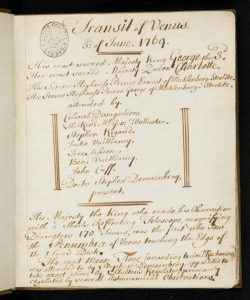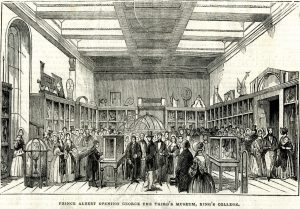King’s College London and its archives relating to the long eighteenth century
Patricia Methven, Programme Manager, Georgian Papers Programme, King’s College London
King’s College London was founded by Royal Charter in 1829 under the patronage of King George IV for which it is named. Sharing original goals with University College London, it sought to offer a metropolitan counterblast to both the perceived exclusivity and expense of Oxbridge and a practical education modelled on German practice. Where King’s differed in intent was on the matter of religion. Its launch meeting at the Freemasons tavern on 21st June 1828 set the tone. Chaired by the Prime Minister, the Duke of Wellington, and attended by no less than seven archbishops and bishops the context of the College was firmly that of the Church of England although students were not required to be Anglicans. Focusing initially on the humanities, law, science and medicine, the vocational training of theology did not follow until 1846 when a need was recognised for an increase in the number of clergy willing to serve in the burgeoning number of city parishes.
Although hugely expanded in its locations on both sides of the River Thames, King’s original building is still in use located on Crown land granted to the College on a peppercorn rent, the site of the lumber yard of Somerset House. Whilst the suitability of the site raised questions in the press of the day, situated as it was alongside what we now know as the Dickensian rookeries or slums, it was also a burgeoning quarter of Georgian cultural interests. The original Somerset Palace, having been demolished in 1775, was gradually rebuilt and by the time the College opened its doors to students in 1831 was home to the Royal Academy of Arts, the Royal Society and the Society of Antiquaries, as well as the Navy Board. A number of members of these bodies supported the new College through serving as lectures or benefactors.
Amongst the earliest benefactors was William Marsden (1754-1836) a fellow of both the Royal Society and the Society of Antiquaries and between 1795- 1807 successively second and first secretary to the Admiralty. An early career in the East India Company including eight years in Sumatra inspired a fascination with language and a determined collecting interest in examples of early bibles in a variety of languages, a significant number of which were passed to the College in 1835. For more about Marsden and the College holdings of his print collection: http://www.kcl.ac.uk/library/archivespec/special-collections/individualcollections/marsden.aspx. Within the Archives are held examples of 17th and 18th century grammars and vocabularies including examples in Welsh, Icelandic, Kannada, Tamil, Javanese and Tagalog; a manuscript letter from CTde Murr to Marsden , 24th February 1797 regarding the Bibliotheca universalis and accompanying translation; and an Ionian newspaper of 1805 concerning King George III.
Another early benefactor was Phillip Hammersley Leathes, an antiquarian, who the year before his death in 1838 donated a collection of books, papers and medals to the College. Leathes’s collecting interests were wide ranging and he was an active correspondent with other antiquarians. Materials and topics include the discovery of early brasses in the foundations of St Dunstan in the West, Fleet Street; manuscript copies of a narrative by Mr Clare of the Lisbon earthquake, 1755; materials collected on the observations of the comets,1811-14; papers mostly relating to the provenance of the Portland Vase at the British Museum, 1811-25; devotional exercises, an illustrated autograph book previously opened by Casper Johann Northbeeg van Revel with entries dating between 1691-1702; manuscripts by John Anstis, Garter King of Arms, on memorials at Windsor Castle; funeral processions, women bearing arms and the manner of creation of various nobles; and a manuscript volume by Francis Harrison on the elements of navigation ,1757. Leathes interests are also reflected in a number of dictionaries compiled for different languages, genealogies, and examples of title deeds, wills, indentures and residency certificates, 1650-1770. Leathes’s collection also include papers collected in his capacity as the executor of John Carter (1748-1817) a fellow antiquarian and draughtsman. More workaday in nature than Leathes, these papers include samples of handwriting by way of trade cards, a number of drawings notably of architectural detail and memorials of and in chapels and churches and commissioned by wealthy antiquarians. Two volumes in particular (Leathes 7/4) are autobiographical in nature and include depictions of his patrons. They also reflect stories from his family’s history, as a gardener at Windsor Castle and the fortuitous damage to a sculpture in the family’s London premise occasioned by shot fired in pursuit of an escaping highwayman. A full catalogue to the collection may be consulted here: http://www.kingscollections.org/catalogues/kclca/collection/l/10le23-1/?searchterms=leathes.
Among the most remarkable holdings in the archives are manuscripts forming part of the King George III Museum collection. With the encouragement of Stephen Demainbray, astronomer and sometime tutor to the royal children, a private observatory was established in 1769 in Richmond in time to observe the Transit of Venus. This rare event had excited very wide ranging scientific interest with observations and readings being planned across the globe. Most notably the Royal Society of London commissioned Captain Cook to take readings in Tahiti with the specific intention of developing and testing an accurate way to calculate longitude which was regarded as essential to improving naval navigation out of sight of land.

First page of the manuscript notebook, ‘Observations on the Transit of Venus’ (K/MUS/1/1)
Closer to home, is the manuscript notebook (K/MUS/1/1) recording the detailed observations of the event made by the King himself and Demainbray on 3rd June, together with notes compiled by Abraham Gotthelf Kaestner, Professor of Mathematics and Natural History at the University of Gottingen at the Gottingen Observatory together with observations of an earlier lunar eclipse of 1768. These were observations were followed by further series on the transit of the sun, 4th June -15th July taken by Demainbray, Stephen Rigaud, Professor of Astronomy, Oxford and George Wollaston utilising a variety of regulator clocks (K/MUS/1/2) and of the solar eclipse, 4th June, taken by the Royal Astronomer, Nevil Maskelyne (K/MUS/1/3) Associated volumes and texts reflect detailed work in setting up and testing equipment as well as observations reported by learned societies in Europe and made widely in Britain and reported to the British press.
Another volume of 1772 (K/MUS/1/6) in the collection records measurements made during a test of the H5 chronometer created by John Harrison, the clock which finally offered critical accuracy in establishing longitude at sea. The most sustained observations made in the Observatory were the daily temperature, rainfall and pressure readings taken from 1773 to 1840 (see K/MUS/1/7-10).

Engraving of Prince Albert opening the George III Museum, King’s College London. 1843
The scientific equipment in use at the observatory eventually expanded to include mechanical demonstration equipment including spring balances, levers and an Archimedes screw; electrical apparatus including Leyden jars, electroscopes and batteries; and navigational and astronomical instruments including globes, orreries, theodolites, and telescopes. Some were plainly built and used in teaching by Demainbray, whilst others represented the finest examples of the instrument makers’ craftsmanship. In 1841 a decision was taken to disperse the collection. Some items were transferred to the British Museum and the Armagh Observatory and a small number retained by the Royal Household. The majority were presented to the College by Queen Victoria as the basis for a new King George III Museum where they could continue their use as a teaching collection and be available for public view. Regular visitor books and accessions books were compiled (K/MUS/4). By 1926, however, the collection’s use for the teaching contemporary science had dwindled and the College transferred the collection on loan to the Science Museum. On display for many years, in 2018 significant items will form the nucleus of the Museum’s new Enlightenment gallery.
King’s College London’s own institutional archives include a rich record of its early days including minutes from 1828; correspondence; accounts and share certificates of early benefactors and contributors; title deeds from 1678 the earliest notably relating to properties near the original site in Strand Lane and Surrey Street; and student records from 1831. The twentieth century mergers of the College medical school with those of St Thomas’s and Guy’s Hospitals is reflected in in collections of prints, drawings, engravings and paintings of people and hospital and nearby buildings in the Southwark and London Bridge respectively from 1720 and 1647 onwards. Student and pupil records date from the 1720s. Administrative records for both medical schools date from the early 19th century and for Guy’s there are also clinical records from 1801. Items of note for the 18th century include a surgical casebook, 1725-6, describing lithotomy and cataract surgery compiled by Charles Oxley and for Guy’s the papers of the weekly discussion group, the Physical Society, 1775-1851.
